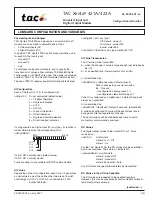
Versatrax 150™
Document: UMDW014058.docm
Revision: A03
Created by: KW
Date: 10 Oct 2019
3075415-A03
Source Location: C:\ePDM\ISLEng\products\dw-versatrax150mkii\manuals\UMDW014058.docm
Page 50 of 57
User Ma
nual
Vehicle Recovery
The Versatrax
™ vehicle is designed for quick, efficient recovery by using the winch to tow it out of the
pipe. Just how quickly recovery can proceed will depend on the condition of the pipe and how far the
vehicle has traveled. Some factors may slow down recovery, such as distant travel into the pipe, bends
and corners.
If using an
AC powered
winch, do the following:
1. Begin retrieval by driving backwards a very short distance. This will disengage the track drive
clutches for towing with the winch.
2. If the vehicle has gone a long distance down the pipe it may require an excessive force on the
tether from the winch to tow the vehicle. To prevent this, begin by driving the vehicle in reverse
while simultaneously running the winch, hence taking the load of the vehicle off the tether.
3. Carefully watch the rear facing camera (if installed) whenever the vehicle is in reverse. Ensure
the tether is towed from behind the vehicle and there is adequate tension to avoid it going slack
behind the vehicle. Accidentally driving over the tether runs a high risk of breaking the tether or
jamming the vehicle.
4. If the tether tension does not seem excessive, and you know (from the inspection) that the pipe is
clear, you can tow the vehicle out with the winch. The winch will tow the vehicle between 60 and
100 feet per minute, depending on how full the drum is.
5. When the vehicle arrives at the deployment hole, stop towing and resume driving the vehicle. As
the vehicle comes under the opening the tow cable and back of the vehicle will begin to lift. At
this point stop and attach the lifting hoist.
Caution:
Driving forward while the vehicle is being towed backwards by the winch
may damage the Minitracs™.
If you are using a
portable reel
the vehicle must be driven backwards while the tether is reeled in by
hand. The retrieval is similar to the powered winch. Follow these steps:
1. In order to ensure the tether is wound properly, have someone operate the level wind and spool
the tether as the vehicle is reversed.
2. Make sure the friction brake is
engaged
.
3. Make sure there is no slack in the tether on the reel.
4. As the tether is being wound, track the level wind back and forth so that the tether lies tightly
against itself in the reel.
5. Once the vehicle is recovered, pack up the reel in reverse order of setup.
6. Make sure the packing brake is engaged and the crank handle is removed and replaced with the
shipping cap.
7. If there is water pooled in the case from a wet tether, there is a plug at the bottom that may be
removed to allow the case to drain; always replace the plug after draining.








































